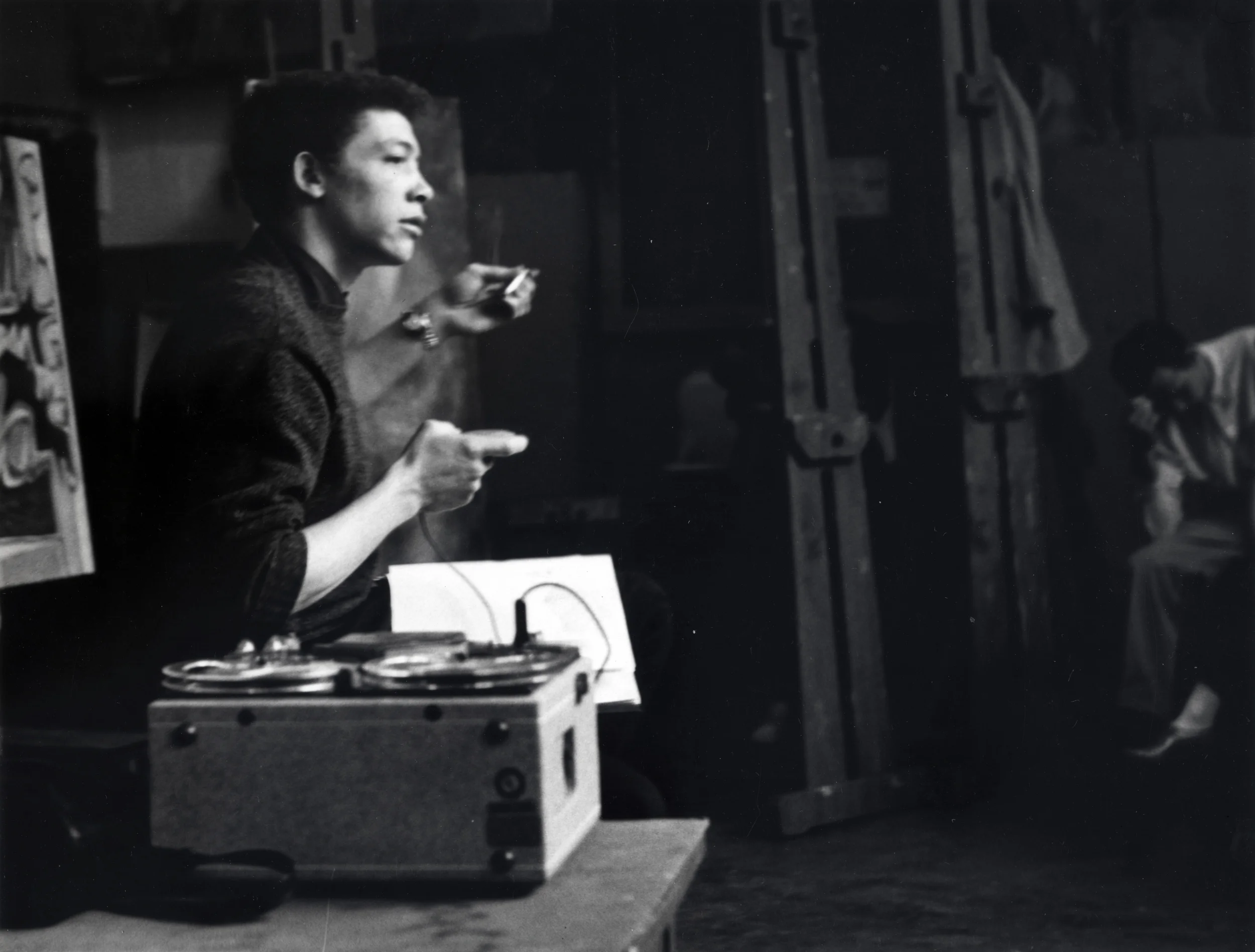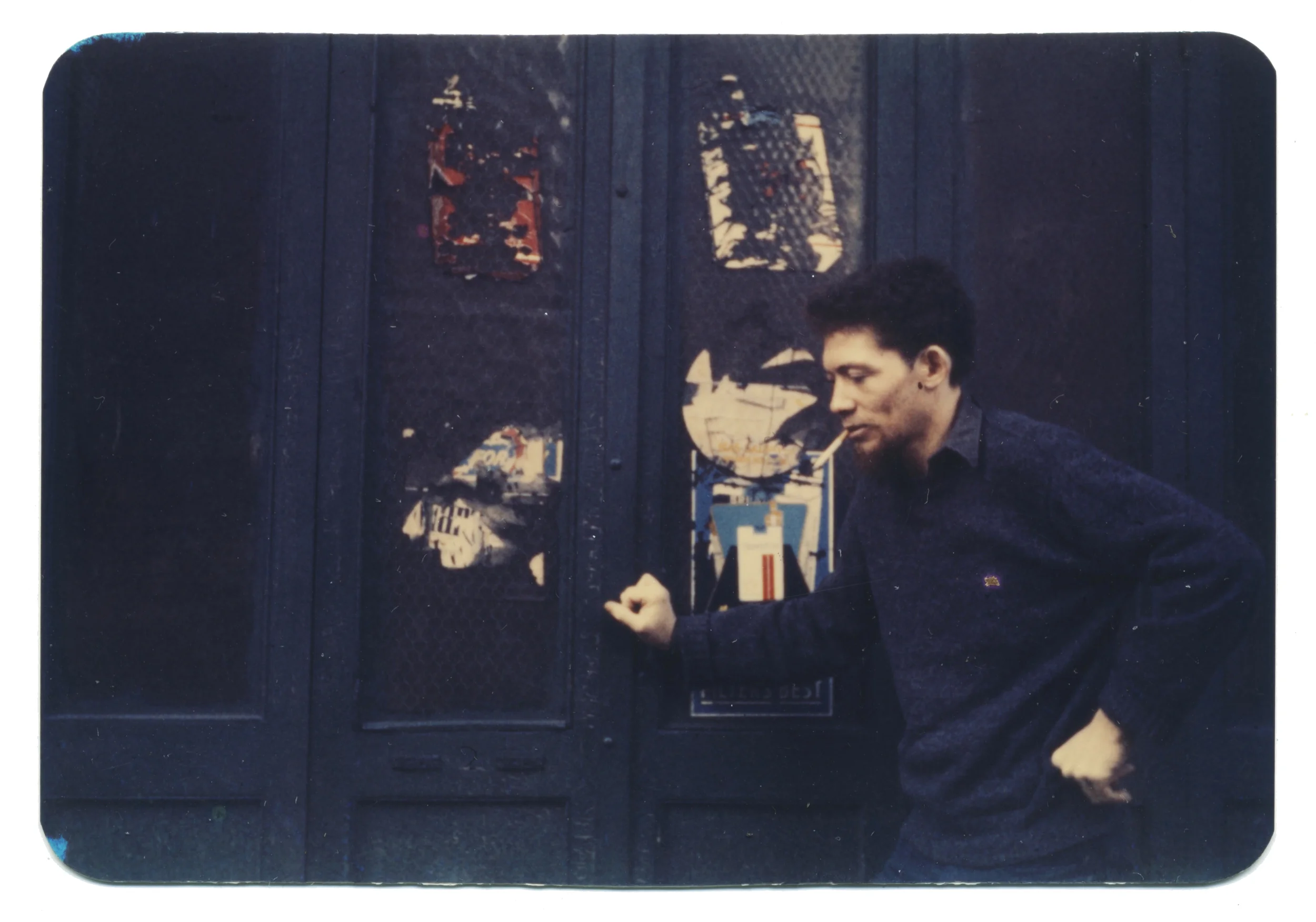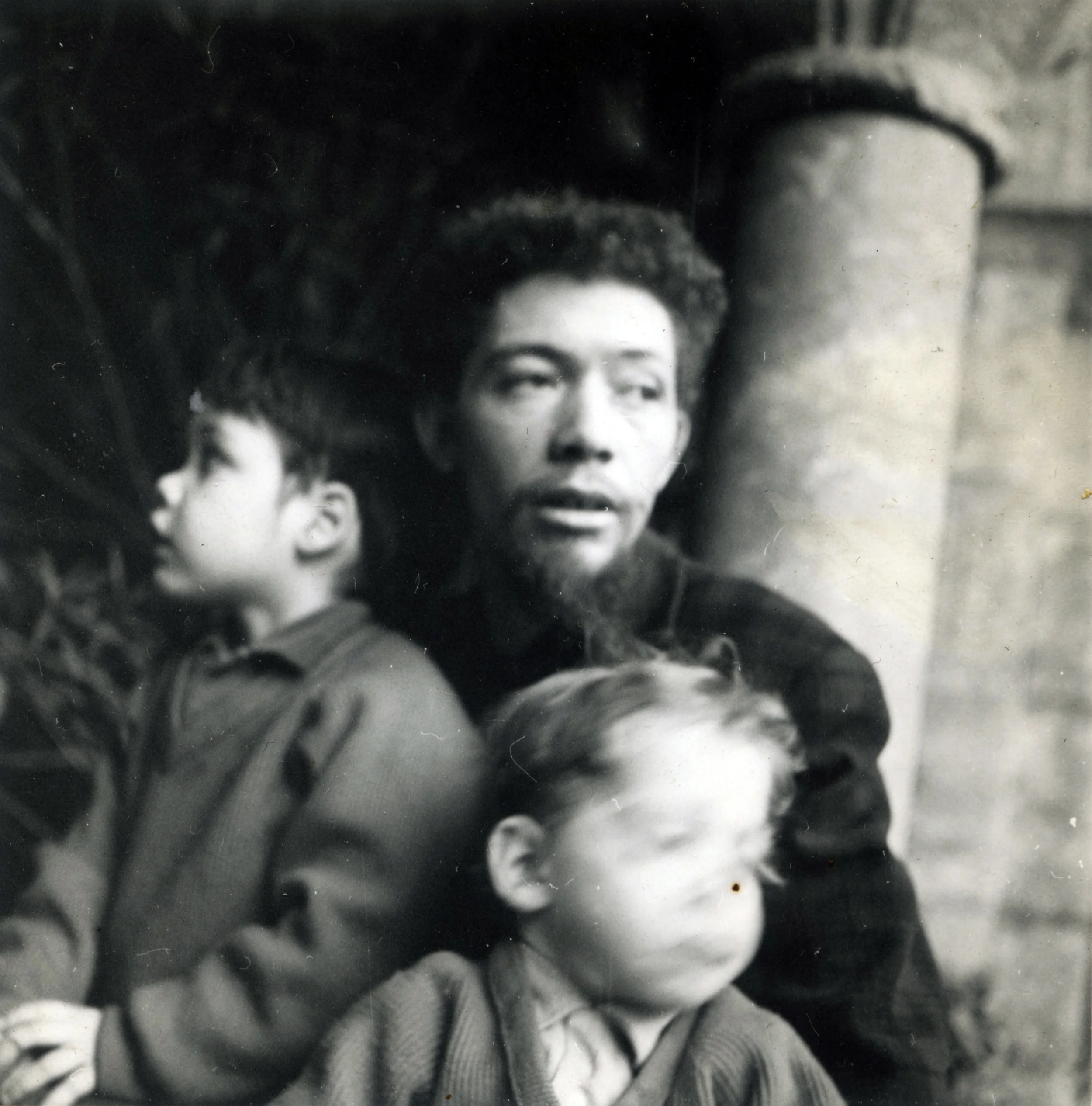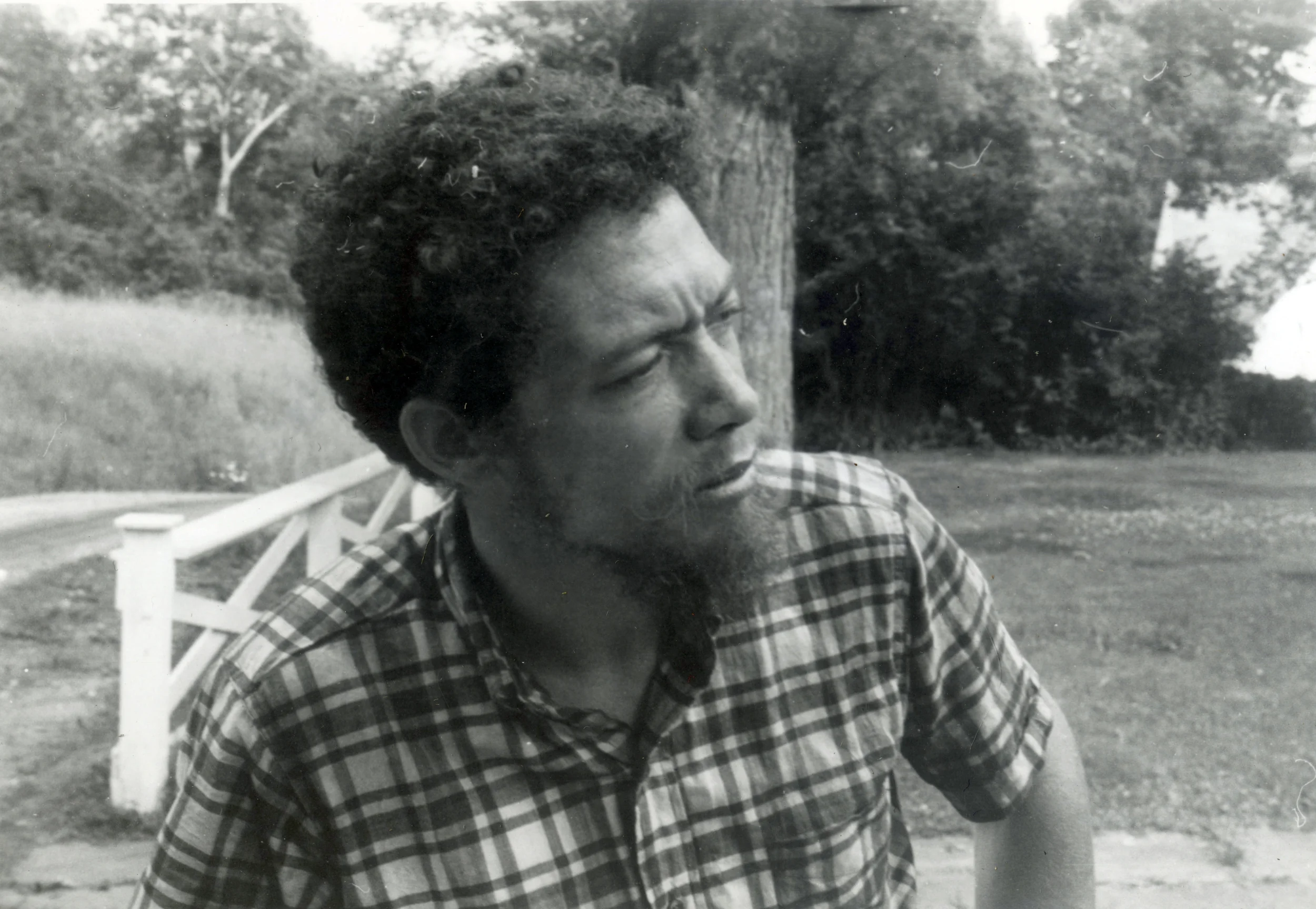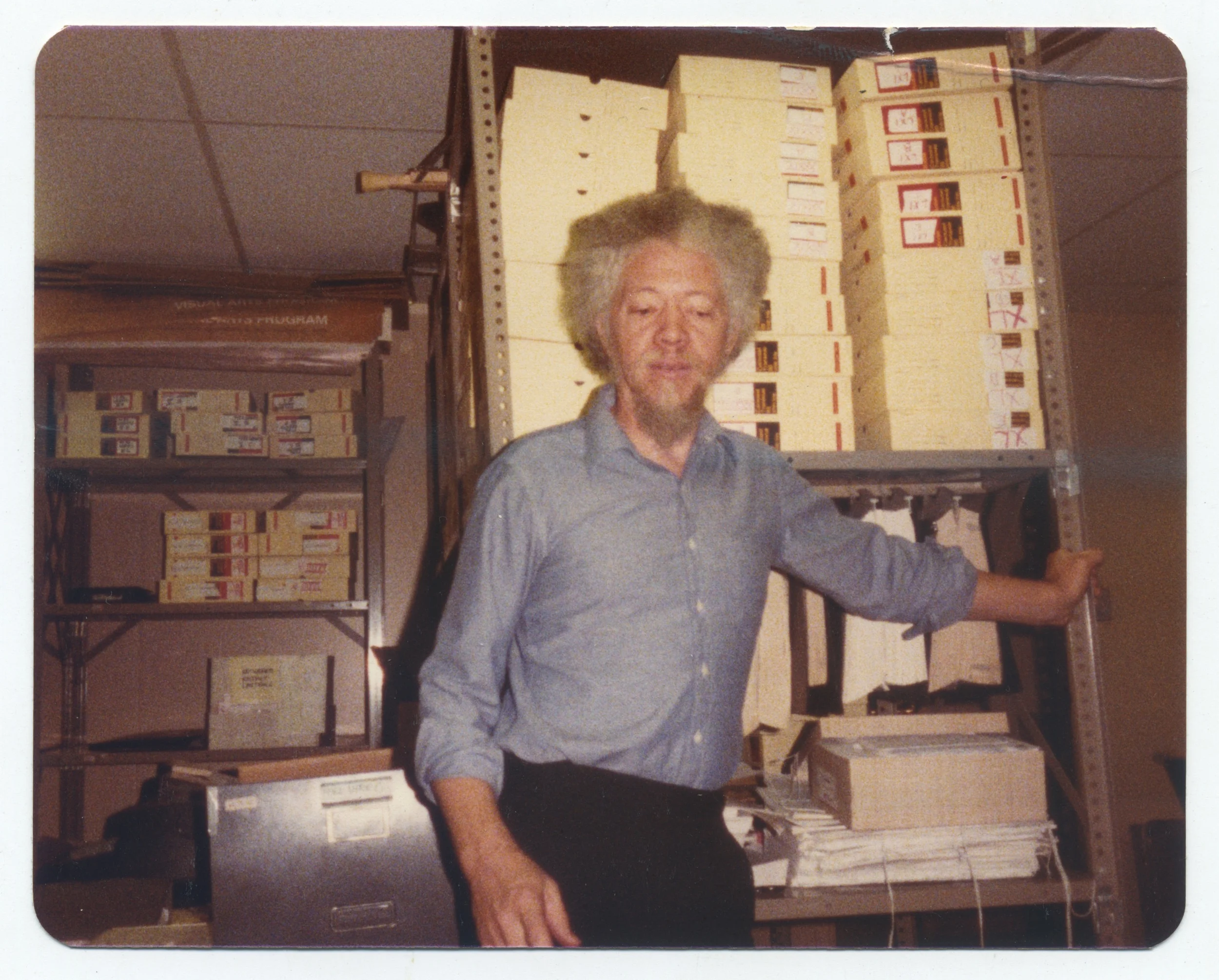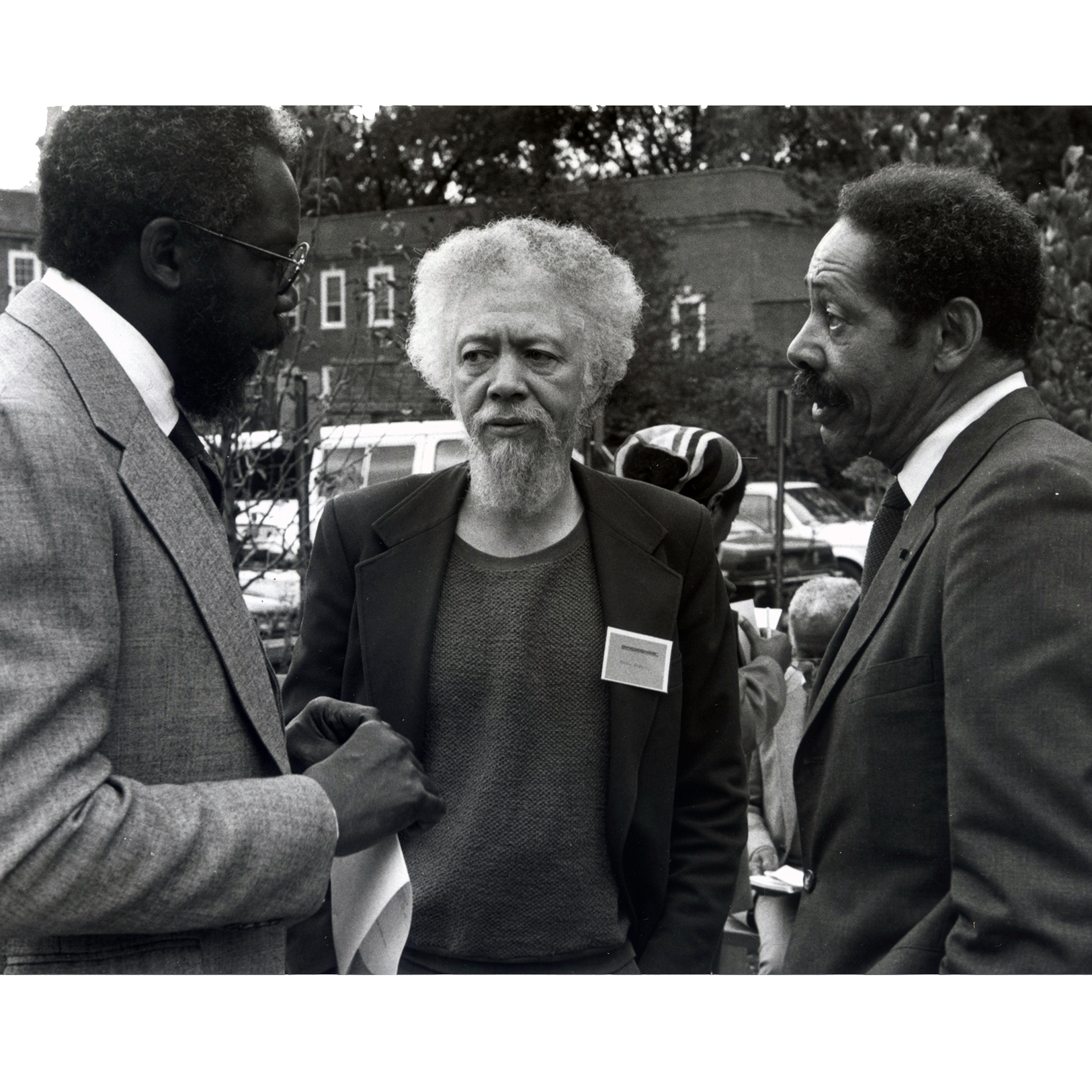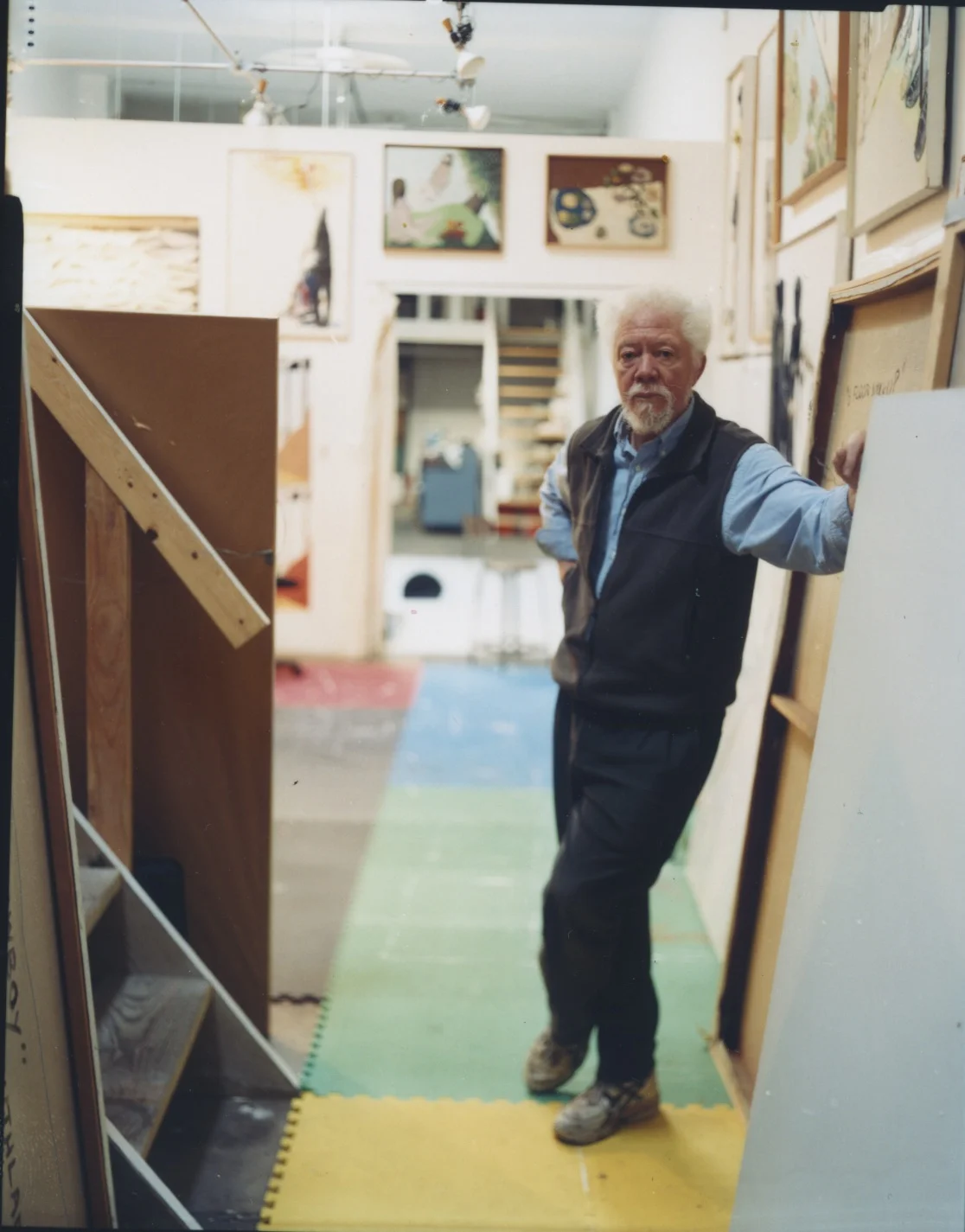
The following is an illustrated timeline of Benny Andrews’ biography. For a more detailed account of his life and career, see Andrews’ CV & Chronology.
Benny and sister Val, c. 1934
1930-1943
Benny Andrews is born on November 13, 1930, in Plainview, Georgia, a farming community three miles from Madison, to George and Viola Andrews. He is one of ten children. George is a sharecropper and self-taught artist.
Andrews begins working in the fields as a young child. He also attends Plainview Elementary School, a one-and-a-half room log cabin built by Plainview's African American community.
Benny Andrews, c. 1947
1944-1947
Although education past the seventh grade is severely discouraged in the sharecropping system, Andrews’ mother, Viola, determined that her children will make it through high school, works out an arrangement in which Andrews will attend school when it is not possible to work in the fields.
Andrews at Fort Valley State College
1948-1949
Andrews is the first in his family to finish high school. With a small scholarship from the 4-H Club, Andrews attends Fort Valley State, one of the three black state colleges in Georgia. He gravitates to the school's small art department, but struggles academically.
Andrews in the US Air Force
1950-1954
With the end of his scholarship, failing in almost every class, and frustrated by the lack of opportunity to study art, Andrews enlists in the US Air Force in July 1950. During his service, he uses his Air Force salary to support his mother and youngest siblings. He serves for the entire duration of the Korean War, attaining the rank of Staff Sergeant and receiving an honorable discharge in July 1954.
Andrews in class at the School of the Art Institute
1954-1958
After the war, funding from the GI Bill enables Andrews to attend the School of the Art Institute of Chicago. Despite his work in the art department at Fort Valley State, he arrives at school with little formal training.
Andrews later recalled that his arrival at the Art Institute was revelatory because it was both his first time in an art museum, and his first time in a city or cultural facility without segregation.
Drawing from Benny Andrews sketchbook, 1955
1954-1958 continued
In school, Andrews develops his technical drawing and painting skills and broadens his knowledge of art history and design. To complete the requirements of his BFA degree, he also enrolls in academic evening classes at the University of Chicago. Outside of class, he explores the city of Chicago, drawing the people and places he encounters, and finds a side job sketching live music performances in Chicago’s jazz scene.
Boris Margo teaching at the School of the Art Institute of Chicago, 1958
1954-1958 continued
Andrews’ interests are often at odds with the aesthetics of Abstract Expressionism that heavily influence the School of the Art Institute's curriculum. He finds encouragement with instructor Boris Margo, who pushes Andrews to pursue his own style and subject matter. In his final year, Andrews begins incorporating roughly collaged material into his painting, a technique he will continue throughout his career.
Benny Andrews on the Lower East Side, New York, 1958
1954-1958
Andrews marries Mary Ellen Smith in 1957. In summer 1958, he graduates from SAIC, and in July he and Mary Ellen move to New York City. That same month, Mary Ellen gives birth to their first child, Christopher. Andrews finds an apartment for the family at 130 Suffolk Street on the Lower East Side. Benny paints at home and cares for the baby while Mary Ellen works as a secretary.
Andrews on sculptor George Segal's New Jersey farm, 1963
1960-1963
In 1960, Paul Kessler gives Andrews his first solo show at his gallery in Provincetown, MA, and in 1962, Bella Fishko invites him to become a member of the Forum Gallery in New York, mounting a solo exhibition of his work that same year.
As Andrews establishes himself in New York, he meets members of the city’s diverse artist community, including Red Grooms, Bob Thompson, Mimi Gross, Lester Johnson, Naim June Paik, George Segal and Jacob Lawrence.
Andrews at his 1964 solo exhibit at The Forum Gallery. Photo Credit: Marvin Bolotsky
1964-1965
Andrews and Smith’s third child, Julia, is born, and the family moves to a loft studio on Beekman Street, near the Brooklyn Bridge. The Forum Gallery mounts another solo exhibit of Andrews' paintings, and Andrews, with funding from a John Hay Whitney Fellowship, returns to rural Georgia, where he reconnects with family and creates a group of works he titles Autobiographical Series.
Alice Neel's lithograph, Benny Andrews, 1978. Courtesy of the Estate of Alice Neel
1966
Despite initial resistance, the Autobiographical Series is shown at Forum in 1966; it is Andrews last exhibition with the gallery.
Andrews and painter Alice Neel are part of a three-person exhibition at the Countee Cullen New York Public Library with artist Tecla Selnick. Neel and Andrews form a lifelong friendship. Neel paints Benny and Mary Ellen Andrews in 1972 and creates a lithograph portrait of Andrews in 1978. Andrews completes his Portrait of Alice Neel in 1987.
Andrews teaching in the South Bronx, 1967
1966-1968
Andrews begins teaching drawing and painting at the New School for Social Research in New York and the Jewish Community Center in Bayonne, New Jersey in 1966, and through an arts initiative in the South Bronx in 1967. In 1968, he begins teaching at Queens College in the SEEK program, which offers academic support for underserved students. He will continue to teach at Queens College for the next three decades.
Founding members and staff at the Studio Museum's opening on September 24, 1968. Invisible Americans would be just its second exhibition. Courtesy of The Studio Museum in Harlem
1968
In October 1968, the exhibition The 1930's: Painting and Sculpture in America opens at the Whitney Museum. The show, which includes over 80 artists, completely excludes African American artists. In response, on November 17, Andrews, Faith Ringgold, Henri Ghent, and others picket the museum and mount Invisible Americans: Black Artists of the 1930s at the newly opened Studio Museum in Harlem.
Benny Andrews' Did The Bear Sit Under a Tree, 1969
1969
In January, a group of artists meet at Andrews’ studio to organize the Black Emergency Cultural Coalition (BECC) to protest the upcoming exhibition Harlem on My Mind: The Cultural Capital of Black America, 1900-1968 at the Metropolitan Museum of Art, for its exclusion of Harlem residents and artists from the exhibition and its planning. The BECC pickets the museum and encourages a boycott of its opening reception.
Andrews lecturing at Boston Museum of Fine Arts, 1970. Photo credit: Betsy Gallantain
1969-1971
In April 1969, Andrews and Henri Ghent meet with officials from the Whitney Museum of American Art to begin negotiations between the museum and the BECC over policies regarding discrimination against black artists. Despite initial progress, Andrews and more than a dozen other African American artists drop out of the Whitney's 1971 exhibition Contemporary Black Artists in America in protest over the show's total lack of African American curators.
Andrews in his studio with No More Games, 1970. Photo credit: Rudolph Robinson
1970-1976
In 1970, Andrews’ painting The Champion (1968) is included in The Afro-American Artist: New York and Boston at the Museum of Fine Arts, Boston, which is co-organized by the National Center for Afro-American Artists; The Museum of Modern Art purchases No More Games (1970), and Andrews has a solo show at at the Acts of Art Gallery, a Black-owned gallery in New York City.
Andrews also begins a lifelong connection with the MacDowell Colony artist residency when he is awarded his first fellowship with them in 1973.
Andrews with his mother, Viola (center) and Civil Rights leaders John Lewis (far left) and Julian Bond (right) at the Lewis’ home, 1975.
1970-1976 continued
Between 1970 - 1975, Andrews creates his Bicentennial Series, a six-year cycle in which each year is dedicated to the production of one monumental painting. He plans the series as a preemptive response to what he rightly assumes will be the exclusion of African American history and identity in the upcoming celebrations for the 1976 American Bicentennial.
In 1976, Andrews and Mary Ellen Smith separate, and Andrews moves to a loft on 26th St.
Andrews giving a demonstration to students Alabama State University, 1975
1970-1976 continued
In 1971, Andrews begins teaching art classes at the Manhattan Detention Complex (also known as The Tombs) as part of a major prison art program initiated under the auspices of the BECC. The program expands throughout the United States. In 1973, Mayor John Lindsay and the city of New York honor Andrews for his work in prisons, and in 1976 he guest curates an exhibition of artwork by prisoners at the Studio Museum in Harlem.
As Art Program Director for the ICRY, Andrews organizes a Youth Day at the Harlem State Building Gallery, 1977
1976
Andrews becomes the art program director for the Inner City Roundtable of Youths (ICRY), an organization comprised of New York City gang members seeking to combat youth violence by strengthening urban communities.
This same year, Andrews protests the Whitney's Exhibition of American Artists, which claims to represent 300 years of American art, but includes no African American artists and only one woman artist.
Raymond (left), Benny, and James Baldwin (right) at the award ceremony for Appalachee Red, Dial Press headquarters, New York, 1979.
1977-1979
In 1977, Andrews draws a series of illustrations for his brother Raymond’s first novel, Appalachee Red, which is published the following year. In 1979 the book receives the first James Baldwin Prize for Fiction. Both brothers attend the award ceremony, where Baldwin personally presents Raymond's award.
During his fourth fellowship residency at the MacDowell Colony in 1978, Andrews meets artist Nene Humphrey and the two become good friends.
Andrews working at the NEA in Washington, DC, 1983.
1980-1984
In 1980, Andrews is included in Six Black Artists at the New Jersey State Museum, along with Jacob Lawrence, Sam Gilliam, Bettye Saar, Richard Hunt and Romare Bearden.
From 1982 to 1984, Andrews serves as the Director of the Visual Arts Program for the National Endowment for the Arts, frequently working in Washington, DC.
Andrews with artists Sam Gilliam (left) and Richard Mayhew (right), 1985
1985-1986
Andrews participates in an exhibition about art and activism of 1960s and 70s at the Studio Museum; SUNY Purchase shows Art is a Family Affair, an exhibition of art made by several members of the Andrews family, including his parents and his brother Raymond.
In 1986, Andrews and Smith divorce.
Extra passport photos of Andrews, 1986
1986-1987
Andrews travels internationally throughout the 1980s. He and Nene Humphrey travel through Europe in 1982, including Vence, France where each artist has a fellowship at the Michael Karolyi Foundation.
In June 1986, Andrews and Humphrey marry and again depart to Europe for two months. In 1987, they return to Europe once again, spending five weeks at the Bellagio Foundation in Italy, both as Rockefeller Fellows.
Andrews teaching, 1988. Photo credit: Myra Schwartz
1987-1988
In 1987, Andrews is elected to the MacDowell Colony's Board of Directors and is named the first distinguished Martin Luther King Jr. - César Chavez - Rosa Parks Visiting Professor at the University of Michigan. The following year he is elected to the Sculpture Center's Board of Directors.
Andrews at an event for the American Series in Mobile, AL. 1993
1988-1993
Andrews has solo museum exhibits at the Studio Museum in Harlem (1988), the High Museum in Georgia (1988), and the Overholland Museum in Amsterdam (1990). In 1993, His American Series is shown as a solo exhibition by the Triton Museum in California, The New Jersey State Museum, The Fine Arts Museum of Mobile, and the Arkansas Art Center.
Andrews at Queens College, 1997
1993-1997
In 1993, the Studio Museum honors Andrews as its Artist of the Year.
In 1995, Andrews has two more museum shows: at the Tubman Museum in Macon, GA and at the Queens Museum in New York. In 1997 The Morris Museum of Art in Augusta, GA mounts American Icons: From Madison to Manhattan, the Art of Benny Andrews, a major retrospective of Andrews' work.
Andrews in 2003. Courtesy of Savannah College of Art and Design, Photo credit: Chia Chong
1998-2006
Between 2004 and 2006, Andrews researches his Migrant Series, traveling the routes of the Dust Bowl migration, the Cherokee forced-march known as the Trail of Tears, and those displaced in New Orleans and the Gulf Coast by Hurricane Katrina.
In 1999, Andrews creates illustrations for a children’s book, The Hickory Chair by Lisa Rowe Fraustino. Over the next five years, Andrews illustrates books for children about the lives of Josephine Carroll Smith, W.W. Law, Langston Hughes, and John Lewis. In 2006, he creates a series of etchings for a limited edition of Flannery O’Connor’s Everything That Rises Must Converge.





